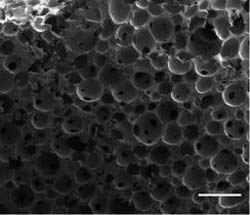All Foamed Up

Packaging, insulation, and impact protection are examples of commercial uses of polymer foams. Depending on the intended application, the properties required of these foams can differ greatly.
In the journal Angewandte Chemie, a team of German, Irish, and French researchers led by Cosima Stubenrauch at the University of Stuttgart has now introduced a new method for the controlled production of structured foams. Their technique is based on the polymerization of foamed emulsions of oil in water.
Not all foams are equal: a kitchen sponge, for example, is not the same as a piece of Styrofoam packaging. Different applications make different demands on a foam, which has led to efforts to control the properties of foams in a targeted fashion. In addition to a foam’s chemical composition, its structure also plays an important role. The property profile of a foam depends on the number and size of the pores, whether the pores are closed off or connected, and the thickness of the polymer supports between the pores.
“The high complexity of conventional production processes, which generate foams from polymer melts and blowing agents, makes control over the morphology and properties of the product a big challenge,” explains Stubenrauch.
An alternative approach involves the use of microscopically small templates to force the foam into the desired structure. For example, tiny droplets of water can be finely dispersed (emulsified) in a solution of monomer, then removed after the polymerization is complete. Another process uses particles to stabilize air bubbles in the reaction mixture.
Stubenrauch’s team has now introduced a new concept for the synthesis of macroporous polystyrene foams: the polymerization of foamed oil-in-water emulsions. Styrene (the “oil phase”) is first emulsified in an aqueous phase. Afterward, the emulsion is stabilized with an anionic surfactant and foamed with nitrogen. This forms bubbles surrounded by tightly packed drops of emulsion. In the third step, the polymerization is initiated by irriadiation with UV light. The drops of emulsion dissolve away, while the structure of the foam—that of the template—is maintained.
The resulting polymer foams contain pores that are partially interconnected through “windows”. “While the high density of the polymer and the strong bonds provide good mechanical stability, the presence of the windows allows air, fluids, or other materials to flow through the foam,” says Stubenrauch. “Control over these properties is desirable for many applications, such as supports, filter agents, or biologically inspired scaffolding. This production technique is simple and versatile and represents a highly promising alternative to other template-based synthetic methods.”
About the Author
Dr. Cosima Stubenrauch is Full Professor and head of the chair “Physical Chemistry of Condensed Matter” at the University of Stuttgart, Germany. She has been working on colloids and interfaces for 18 years. She is also docent at the KTH Royal Institute of Technology, Stockholm, Sweden and the recipient of 11 awards among which the Nernst–Haber–Bodenstein Award 2007.
Author: Cosima Stubenrauch, Universität Stuttgart (Germany), http://www.ipc.uni-stuttgart.de/AKStubenrauch/group/staff/stubenrauch/
Title: Synthesis of Macroporous Polystyrene by the Polymerization of Foamed Emulsions
Angewandte Chemie International Edition, Permalink to the article: http://dx.doi.org/10.1002/anie.201107806
Media Contact
More Information:
http://pressroom.angewandte.orgAll latest news from the category: Materials Sciences
Materials management deals with the research, development, manufacturing and processing of raw and industrial materials. Key aspects here are biological and medical issues, which play an increasingly important role in this field.
innovations-report offers in-depth articles related to the development and application of materials and the structure and properties of new materials.
Newest articles

High-energy-density aqueous battery based on halogen multi-electron transfer
Traditional non-aqueous lithium-ion batteries have a high energy density, but their safety is compromised due to the flammable organic electrolytes they utilize. Aqueous batteries use water as the solvent for…

First-ever combined heart pump and pig kidney transplant
…gives new hope to patient with terminal illness. Surgeons at NYU Langone Health performed the first-ever combined mechanical heart pump and gene-edited pig kidney transplant surgery in a 54-year-old woman…

Biophysics: Testing how well biomarkers work
LMU researchers have developed a method to determine how reliably target proteins can be labeled using super-resolution fluorescence microscopy. Modern microscopy techniques make it possible to examine the inner workings…





















